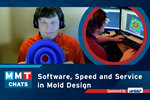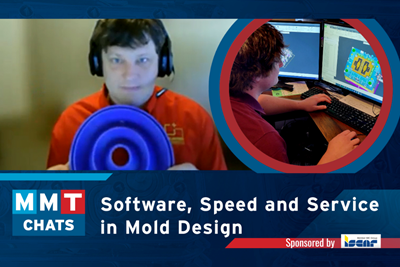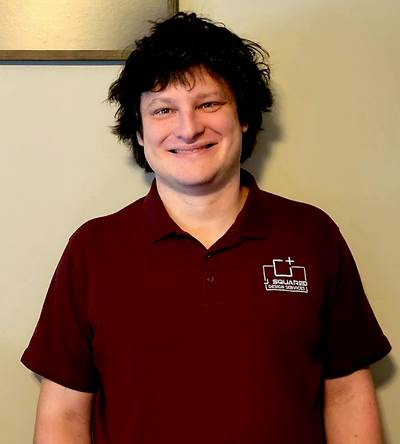
Q: How is your mold design and building apprenticeship project advancing?
I’ve reassessed my approach and am now trying to build something on a local level. Taking on the nation at once was too optimistic, though a well-placed goal. I am working with schools in my area to build interest in manufacturing by presenting to underclassmen at high schools and middle schools. It’s been more challenging than you would expect.
High schools aren’t as interested in placing students in jobs right out of school as they may have been in the past. Our local community college is expanding its machining program, so I’m hoping to make inroads with them in the next five years. This was a big dream with an immediate need; unfortunately, the solutions are not immediate.
Q: What new trends and innovations are you seeing in 3D CAD software that you are excited about?
Most of the advances I’ve seen recently have been geared toward the user experience, which is exciting for engineers just starting out or those who wish to change jobs and, as such, change software. It’s a lot easier to pick up new software today than it was 10 years ago. I’m also interested in seeing how artificial intelligence (AI) will play into designing, though I’m not as optimistic as some.
Many programs already have ways to automate repetitive tasks and if AI can help set up those automations, it could really help. I think the problem of design is still too complex for current AI technology to replicate, so I’d say our jobs are safe for now. However, it should make things easier for designers if the sellers of this new technology don’t price us out.
My 3D printer has been a wonderful addition. There are times when a computer model can’t compete with a physical model you can hold and actuate. It helps with design to show new methodologies of accomplishing a molding function, often for myself.
Q: How has the 3D printer you purchased improved your design services and capabilities?
It’s been a wonderful addition. There are times when a computer model can’t compete with a physical model you can hold and actuate. It helps with design to show new methodologies of accomplishing a molding function, often for myself.
The printer also enables me to prototype plastic parts I’m designing for customers on the fly. I like to think I’m forward with 3D design but sometimes there’s no substitute for being able to hold it in your hand, make two parts interact and see how problems will arise.
Q: What are the biggest challenges facing mold builders today?
I think staffing is the biggest hurdle that we can control to any degree. There are at least avenues we can take to draw in talent, but you must train them. Training would be the next one. Collapsing lead times is another, but other than getting more efficient, you have little choice in the matter with lead times.
The last challenge is the increasing competency of overseas mold builders. It seems like every year they get better at building complex molds with higher quality, depending on the shop. Of course, with increased quality comes price advantages for U.S. shops. Maintaining a high standard of quality is key.
Q: What technological advancements do you predict will have the biggest impact on the moldmaking industry in the next five years?
With staffing concerns, automation will continue to be a strong technology for advancements in all manufacturing industries. This might be AI — and I hate that everyone says that these days — but it might make things simpler and more efficient.
The issue with moldmaking is that it’s typically one-off parts, or at least small runs, so automation that can adapt to changes in work cells will be key. There have already been advancements in this area. I think the trend is going to grow, with the machinist and mold builder roles evolving to match these technologies.
Automation in design and programming has been advancing quickly for quite some time, but I believe it will become more affordable in the coming years for at least basic levels and advance even more in the top tier of software.
Related Content
How to Fix Predicted Warpage Before It Happens with Windage and CAD Model Morphing
Applying windage and model-morphing techniques saved toolmaker/molder Sturgis Molded Products the time, cost, headaches of multiple part/mold design iteration loops, cumbersome cooling fixtures, and long molding cycles.
Read MoreFour Micro Tooling Considerations
Issues involving gating, ejection, mold splits and direction of pull are of special concern when it comes to micro tooling.
Read MoreTips for Tackling Mold Design, Machining, Cutting Tool and Wear Challenges
Tips for tasks ranging from reducing risk in part design and taking advantage of five-axis machining to refining cutting tool performance and reducing wear with guiding and centering systems.
Read MoreWhat is Scientific Maintenance? Part 2
Part two of this three-part series explains specific data that toolrooms must collect, analyze and use to truly advance to a scientific maintenance culture where you can measure real data and drive decisions.
Read MoreRead Next
MMT Chats: It’s About Software, Speed and Service for this Mold Designer
MoldMaking Technology Editorial Director Christina Fuges introduces new MMT Editorial Advisory Board Member Justin Jagels, Owner/President of J Squared Design Services in Arkansas City, Kansas. This episode is brought to you by ISCAR with New Ideas for Machining Intelligently.
Read MoreEditorial Advisory Board 2023-2026: Meet New Board Member Justin Jagels
The 2023-2026 version of MoldMaking Technology’s EAB features a new crew of industry professionals. Here’s one of them.
Read MoreVIDEO: Perspective on A.I. and Mold Design
Bill Genc of TopSolid shares his perspective on the benefits of and barriers to using artificial intelligence in mold design.
Read More























